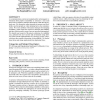Free Online Productivity Tools
i2Speak
i2Symbol
i2OCR
iTex2Img
iWeb2Print
iWeb2Shot
i2Type
iPdf2Split
iPdf2Merge
i2Bopomofo
i2Arabic
i2Style
i2Image
i2PDF
iLatex2Rtf
Sci2ools
CSCW
2004
ACM
2004
ACM
Lilsys: Sensing Unavailability
As communications systems increasingly gather and propagate information about people’s reachability or “presence”, users need better tools to minimize undesired interruptions while allowing desired ones. We discuss the salient elements of presence and availability cues that people use when initiating face-to-face communication. We review problems with current strategies for managing availability, which require the recipient to anticipate unavailability and take explicit proactive steps to prevent unwanted interruptions. We describe our research of the passive collection of availability cues, gathered from user’s actions and environment using ambient sensors and the implementation of a prototype system, Lilsys, which provides machine inferencing of unavailability. We discuss observations and design implications from deploying Lilsys. Categories and Subject Descriptors H.5.3 [Group and Organization Interfaces]: Collaborative Computing—synchronous interaction, CSCW General Term...
Availability Cues | CSCW 2004 | Factors Keywords Availability | Social Sciences | Undesired Interruptions |
| Added | 30 Jun 2010 |
| Updated | 30 Jun 2010 |
| Type | Conference |
| Year | 2004 |
| Where | CSCW |
| Authors | James Begole, Nicholas E. Matsakis, John C. Tang |
Comments (0)

